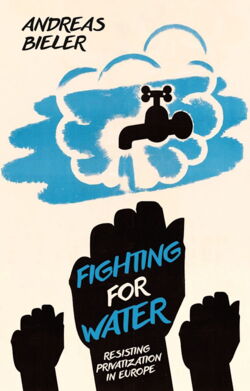Prof. Andreas Bieler

Andreas Bieler (2021) Fighting for Water: Resisting Privatization in Europe. London: Zed Books and Bloomsbury. ISBN: 9781786995087. 224 pp. £24 paperback; £17.27 E-book.
Review by Prof. Andrea Muehlebach, in Global Labour Journal, 2022, 13(2), Page 269. Download als PDF
BIOGRAPHICAL NOTE: Andrea Muehlebach is a Professor of Maritime Anthropology and Cultures of Water at the Department of Anthropology and Cultural Studies at the University of Bremen, Germany.
Fighting For Water: Resisting Privatization in Europe by Andreas Bieler is an inspiring book that makes several lasting contributions: first, an in-depth account of capital’s expropriation of water resources in Europe; second, a powerful argument about movement-building and how successes are achieved when organised labour builds coalitions with broader society; and third, about the question of what political “success” means when battles end in ways that are at times partial, tenuous and incomplete. Moving from national to European scales and back, the book consists of seven chapters, the bulk of which vividly describe how Europe has become a major location of resistance to water privatisation. Increasingly neo-liberalised and authoritarian, the European Union (EU) has incrementally reshaped European societies “in exactly the way that lobby groups have demanded for many years” (p. 95), meaning that Europe has seen the financialisation of pensions and public services such as rail, telecommunications, postal services and energy, that the privatisation of public goods is routinely imposed in exchange for bailout agreements, and that the European Commission can directly intervene in national wage-setting systems to reduce trade union power and erode wages and working conditions.
Yet Bieler demonstrates that the privatisation of public water systems is a tricky affair, with massive mobilisations often following such a move. These struggles were effective because they straddled the spheres of production and reproduction, the factory and the household – two realms that the privatisation of water ties together intimately since privatisation always affects both. On the one hand, privatisation affects utility workers as private companies tend to reduce the number of employees and lower wages. On the other hand, corporate profits are always gained through higher pricing and disinvestment from infrastructure. Bieler gives many examples, including the scandalous UK case, where utility privatisation in the late 1980s led to price increases as high as 50 per cent. Today, Thames Water pays more dividends to shareholders than it earns in post-tax profits. This pattern has repeated itself in many parts of Europe and intensified with the Eurozone crisis, with disproportionate consequences for poorer households and especially women.
Broad anti-privatisation coalitions responded by developing a dynamic set of lateral strategies that implicated and co-constituted each other. Fighting for Water thus shows that the parameters of the economic system are never a pre-given totality. Instead, they are profoundly shaped through a whole range of creative on-the-ground struggles. Moving across Italy, the EU level, Greece and Ireland, the book documents the successful 2011 Italian referendum against water privatisation, how the European Federation of Public Service Unions (EPSU) launched the 2012–2013 European Citizens’ Initiative (ECI) on “Water and Sanitation as a Human Right”, the struggles that ensued in Greece when the EU sought to impose the privatisation of two highly efficient and profitable public water companies in Thessaloniki and Athens, and the 2014–2016 struggles over water charges in Ireland. Throughout, Bieler analyses how labour coalesced with the wider “social factory”. The success of the Italian referendum, for example, was directly indebted to relentless organising from below. Yet it was only able to scale up through a broad alliance of social movements, development NGOs, environmental groups and unions, all of which framed their campaign beyond party politics. This is not to say that coalition-building was easy. Some unions asked whether they should only be tasked with looking out for their members, while others participated in what was a broader argument against the commodification of water and for the commons and democratisation. Scale also mattered, with national-level representatives responding differently to local and regional trade union organisers, who frequently supported the water movement and its broader goals.
The European Citizens Initiative “Right2Water” campaign, in turn, was directly inspired by Italian successes. The EPSU built a similar alliance that promoted a variety of objectives broad enough to allow groups as disparate as trade unions and environmental NGOs to support the cause. While the EPSU administered the campaign and sustained it financially, it was significantly supported by the European Water Movement (EWM) as well as national-level organisations. In countries like France, union support for the ECI was lukewarm, with workers unwilling or afraid to campaign against “their” corporations (Suez and Veolia). Resonance among unions in the UK was similarly tepid. And yet, the ECI was a resounding success, with signature quotas reached or exceeded in thirteen European countries.
In Greece, unions built on existing organising that had arisen in light of the debt crisis. In Thessaloniki, the mood of disobedience and anti-austerity struggle, including a national “Won’t Pay” movement, merged with union mobilisations (including a union hunger strike and member refusal to disconnect households due to non-payment). The coalition here was again a broad alliance of unions, civil society actors and the majors from eleven municipalities. In Ireland, trade unions also played an important role after initial mobilisations bubbled up from below, when local communities began to physically block water meter installation, publicly burn bills and engage in non-payment campaigns. But it was officers from the retail trade union Mandate and the general union Unite who were eventually entrusted with building a national campaign. As was the case in other parts of Europe, water turned out to be an issue of such symbolic potency that broad sectors of society could be mobilised. Bieler thus rightly insists that “we should not automatically write off trade unions’ potential, progressive allies” when analysing water movements (p. 15).
The aftermath of organising against water privatisation has been significant. Between 2000 and 2015, 235 municipalities in 37 countries affecting 100 million people re-municipalised their utilities. Some of these occurred in Europe, most famously in Berlin, Paris and Naples. In Turin and Milan, water companies are still fully owned by local governments because of popular pushback and because laws forcing the partial privatisation of water utilities have for now been revoked. Berlin and Thessaloniki have become “blue communities”, which means that they have committed to keeping water public, to protect water and sanitation as a human right, and to phase out bottled water. While Irish activists are right to argue that none of their objectives (complete abolition of domestic water charges, an end to domestic water metres, the disbanding of Irish Water, and a referendum to provide constitutional protection against water privatisation) have been met, they can look back on a massive campaign that for now has at least stalled the charge to privatise. On the EU level, the ECI also had some direct policy impacts. Water was officially excluded from the 2014 Concessions Directive, a huge win since water utilities were to make up half of the concessions within the EU.
This leads me to one of the book’s most significant contributions, which is to ask what political “success” even means when the battles fought often lie suspended or constantly encounter obstructions and delays. What do we make of the unstable truce that has been achieved between water movements, a thoroughly neo-liberalised European project, and investors still waiting to profit from water? How can one not be disappointed by the European Commission’s refusal to directly introduce water as a human right into EU legislation, arguing instead that this is a matter of national legislation? How can one not be discouraged by the fact that the EU’s 2019 Drinking Water Directive is a weak text that no longer mentions the ECI?
Fighting for Water excels at showing that these mobilisations have not only had significant effects but also given us many additional gifts: a series of exemplary campaigns that show that water can bind together disparate social actors into tight and effective political projects, as well as a cornucopia of brilliant ideas that have fuelled the collective political imagination. The Italians, for example, made major innovations in their theories and practices around participatory democracy and their insistence on water-as-commons, opening up ways to imagine new forms of public ownership and collective law-making. In cities like Paris and Grenoble, public management has been re-invented altogether, with civil society representatives sitting on boards of directors with local government representatives, and with equal voting rights. This means that spaces now exist for citizens to engage in decisions on investment, technology and price setting. The example from Thessaloniki is also interesting in that it (in its initial phases, at least) put on the table the idea that citizens buy non-transferable shares in the state-owned water company, meaning that the public would cooperatively own the water and sanitation company. The water movement has also worked to develop powerful ways in which campaigns can be effectively framed. In some cases, the argument for democracy and the commons was paramount. In others, such as the ECI campaign, the framing of water-as-human-right turned out to be the most effective way forward. Mobilisations around water, in short, have achieved that water and the question of privatisation has reached a “completely new status in public awareness” (p. 90), with our political language and imagination transformed in ways that will guide mobilisations for years to come.
